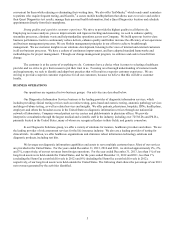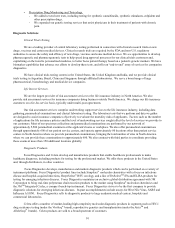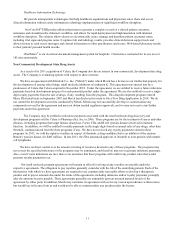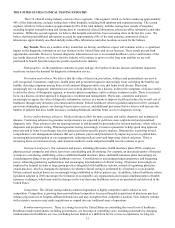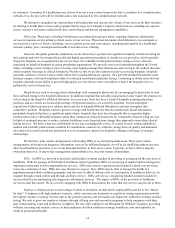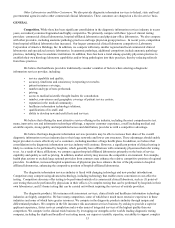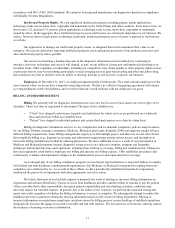Quest Diagnostics 2013 Annual Report Download - page 17
Download and view the complete annual report
Please find page 17 of the 2013 Quest Diagnostics annual report below. You can navigate through the pages in the report by either clicking on the pages listed below, or by using the keyword search tool below to find specific information within the annual report.13
coding, changing medical coverage policies (e.g., healthcare benefits design), pre-authorization of lab testing, requiring co-
pays, introducing lab spend management utilities and payment and patient care innovations such as accountable care
organizations and patient-centered medical homes. While pressure to control healthcare costs poses a risk to our Company, it
creates an opportunity for increased utilization of testing as an efficient means to manage the total cost of healthcare. We
believe that it also creates greater opportunities for low-cost providers, like our Company, as compared to other providers.
Healthcare utilization. In the past few years, growth in healthcare utilization in the United States has slowed. There
may be many factors contributing to this result, including sluggish employment growth, under-employment in the work force,
patients delaying medical care and increased patient financial responsibility for medical care.
Legislative, regulatory and policy environment. Government oversight of and attention to the healthcare industry in
the United States is significant and increasing; healthcare payment reform is a top issue. The FDA has announced several
regulatory and guidance initiatives that may impact the clinical laboratory testing business, including by increasing regulation
of laboratory-developed tests ("LDTs") and analyte specific reagents. Federal healthcare reform legislation adopted in 2010
has created significant uncertainty as healthcare markets react to potential and impending changes. For example, states may
opt out of Medicaid expansion and employers may discontinue offering group health insurance to their employees, shifting
more people to exchange products.
Globalization. There is a growing demand for healthcare services in emerging market countries. Opportunities are
arising to participate in the restructuring or growth of the healthcare systems outside the United States. Additionally, our
customers are establishing positions outside the United States. Demographic changes globally also may create opportunities.
Customers and Payers. We provide diagnostic information services to a broad range of customers, including
physicians, hospitals, IDNs, patients and employers. In many cases, the customer that orders the services is not responsible to
pay for them. Depending on the billing arrangement and applicable law, the payer may be the patient or a third party; in some
cases, patients may bear responsibility for a portion of the payment. Examples of potential third-party payers include health
insurance plans, self-insured employer benefit funds, accountable care organizations, patient-centered medical homes, the
traditional Medicare or Medicaid program, physicians or others (e.g., a hospital, another laboratory or an employer). In light of
health care reform, there is increased market activity regarding alternative payment models, including bundled payment
models.
Health plans. Health plans, including managed care organizations and other health insurance providers, typically
reimburse us as a contracted provider on behalf of their members for diagnostic information services performed.
Reimbursement from our five largest health plans totaled less than 20%, and no one health plan accounted for 10%, of our
consolidated net revenues in 2013.
Health plans typically negotiate directly or indirectly with a number of diagnostic information services providers, and
represent approximately one-half of our total clinical testing volumes and one-half of our net revenues from diagnostic
information services. The trend of consolidation among health plans has continued. In certain locations, health plans may
delegate to independent physician associations (“IPAs”) or other alternative delivery systems (e.g., physician hospital
organizations, accountable care organizations and patient centered medical homes) the ability to negotiate for diagnostic
information services on behalf of certain members.
Health plans and IPAs often require that diagnostic information services providers accept discounted fee structures or
assume all or a portion of the financial risk associated with providing such services through capitated payment arrangements
and discounted fee-for-service arrangements. Under capitated payment arrangements, we provide services at a predetermined
monthly reimbursement rate for each covered member, generally regardless of the number or cost of services provided by us.
Health plans offer preferred provider organization (“PPO”) plans, point-of-service (“POS”) plans, consumer driven health plans
(“CDHPs”), high deductible plans and other coverage programs. Reimbursement under these programs is typically negotiated
on a fee-for-service basis. To the extent that plans and programs require greater levels of patient cost-sharing, this could
negatively impact patient collection experience.
Most of our agreements with major health plans are non-exclusive arrangements. Certain health plans have limited
their diagnostics information services network to only a single national provider, seeking to obtain improved pricing. Health
plans also are narrowing their provider networks.
We also sometimes are a member of a “complementary network.” A complementary network generally is a set of
contractual arrangements that a third party will maintain with various providers that provide discounted fees for the benefit of




